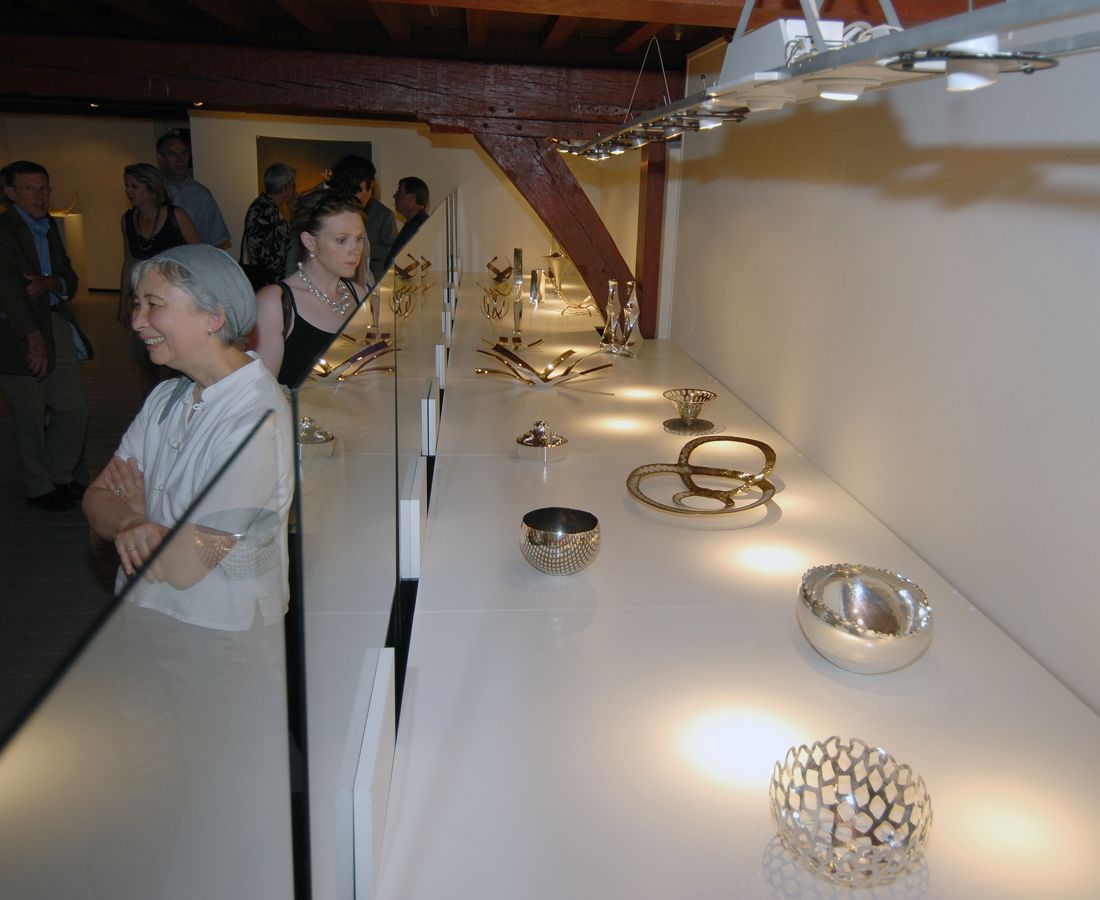From 9 July – 24 September 2006 the exhibition METAALMORFOSE, Jan van Nouhuys zilverkunst, took place in Museum Flehite at Amersfoort. The main reasons for the museum to organise the exhibition were that Van Nouhuys has been working as a silversmith now (2006) for 30 years and that he was born and bred in Amersfoort. The emphasis was on recent work.
A catalogue was published by the museum, which you can order at Gallery Studio 925.
Eric Turner, curator of the Metalworkdepartment of the V & A Museum in London, gave the openings speech:
'It is useful to remind ourselves that the Dutch 17th century silversmiths, the Van Vianens in particular, were some of the most accomplished in Europe. Christiaan van Vianen was appointed royal goldsmith to the court of Charles I, whose cultural sophistication was only excelled by his political stupidity, the result of which we all know. I am continuing at least in a very minor way the patronage of Dutch contemporary silver. But I have kept my head on my shoulders so far.'
Turner cites from an article by R. Lightbown about the work of the Van Vianens, concluding that 'the objects were conceived as major works of art, their function being rather secondary.' 'This is important to know,' stresses Turner.
'The result is a style of goldsmithing work where the traditional architectural approach to design is abandoned for a sculptural manner, with subtle undulations of relief and plastic freedom. In other words, an extremely rich plastic style which I believe has parallels with Jan's work.'

Turner explains his role at the V & A and his responsibility for the collection of contemporary silver. He has made a number of substantial acquisitions over the last 30 years, one of them being 'a pair of immensely striking and extremely accomplished candlesticks made by Jan'.
He was introduced to his work for the first time in 1999 at the Olympia Fair where Jan and Anneke took part : 'A brave and bold decision on their part, for this is a fair, primarily concerned with 18th, 19th, at a push early 20th century works of art.'
'What is happening and what is happening with the work of Jan is that we have an idiom which is being reworked and reworked in a thoroughly contemporary way, but which can nonetheless be traced back quite deliberately, quite clearly to certain 17th century antecedents. And it is that, quite apart from the skill and virtuosity of the pair of candlesticks, that made me very excited.'
Turner then gives details about Jan's career. He mentions the fact that Jan worked for the firm Wackely & Wheeler in London and stresses the point that such a well-established firm found it a struggle to survive, and indeed they did not. They demised in 2003. 'I have the utmost respect for anyone who can actually survive, let alone succeed as a silversmith, whether it is a silversmithing firm, or whether it is an individual studio. And I think we must actually bear this in mind in evaluating and appreciating Jan’s success and the exhibition that we have here.'
‘I think his work must be viewed within a historic tradition. Surprisingly perhaps, but understandingly nonetheless, modernism is now a very well-established 20th century phenomenon.’

‘Other notable achievements by Jan which I should make brief mention of stem specifically from his immense dedication to his work, from his immense dedication to the role of silver in modern society, and his intense belief that it has a fundamental and vital role to play. He has been responsible for setting up a group called Silver in Motion (Zilver in Beweging).’
Its chief aim was to promote the cause of modern silver by various means, ‘and I am afraid contemporary silver today does really need this energy and devotion to it.’
Turner compares the British and Dutch situation. There is in Britain the ABDS (Association of British Designer Silversmiths), a somewhat similar group as Zilver in Beweging, not state-supported. And there are the Goldsmiths’ Company, going back to the 13th century, and the British Crafts Council, both of which are active in promoting the cause of contemporary silver. ‘We have these two institutions, which are not exactly duplicated here, and it is that that has made the Silver in Motion exercise so particularly important, and indeed it has had very definite results.’
‘I like to also add Jan’s work in India in the 1990’s, where his particular achievement was to upgrade the work of a group of silversmiths beyond all their expectations and recognition. His adherence to a very high and consistent standard of quality, is exemplary. And for that too he has to be congratulated, quite apart from producing an extremely significant and important body of work, which we can see here.
For all of these reasons it gives me great pleasure and it is a great honour to have been invited here to be able to declare this exhibition open !’













